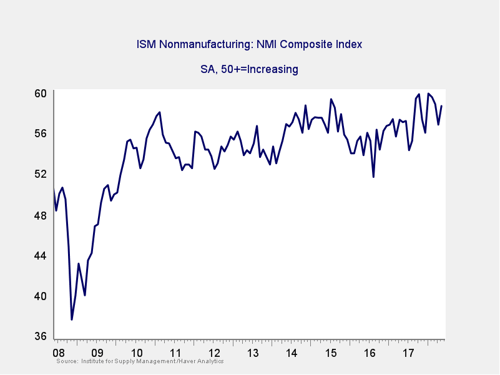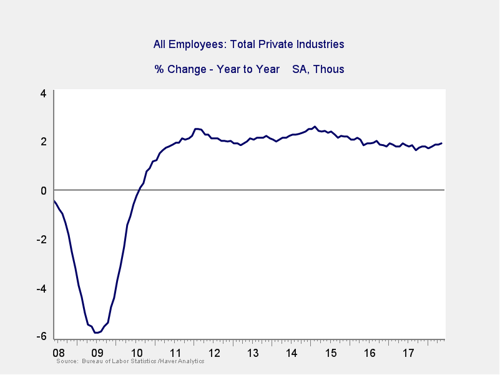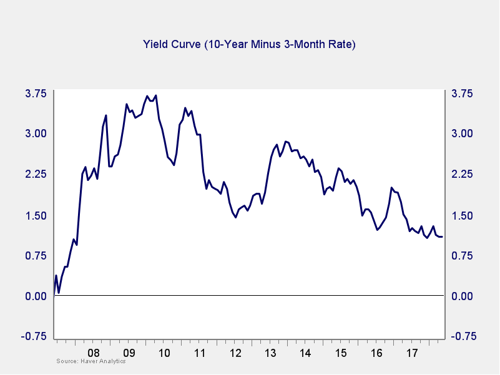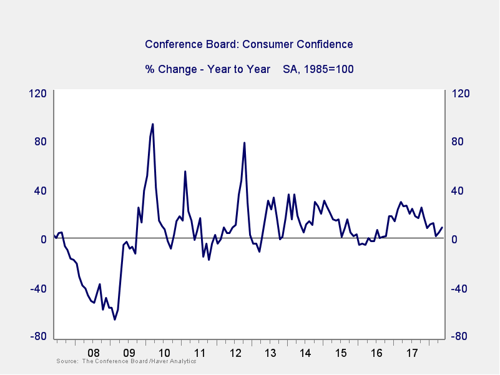May’s data improved over an already solid April. Job growth accelerated further, and consumer confidence remained strong. Business confidence also bounced back, taking the trend back to positive territory. Finally, Fed policy continues to be stimulative, which is helpful despite the likely rate increase this month. Overall, the economic data indicates that growth continues and that the recent soft spot may be passing.
The Service Sector

Signal: Green light
Business confidence bounced back after a two-month decline, returning it close to peak levels. The bounce—to 58.6 for May—beat expectations, leaving the index at a level that supports faster growth. This is a diffusion index, where values above 50 indicate expansion. Its continued strength suggests that growth is likely to continue in 2018, but the recent pullbacks indicate that growth may be peaking. These levels of confidence should keep driving economic growth for some time, however, leaving this indicator at a green light.
Private Employment: Annual Change

Signal: Green light
May job growth came in at 223,000, while April was revised up from 159,000 to 164,000. These numbers suggest that March’s weak report was an outlier and that job growth continues. On an annual basis, job growth remains strong and is actually improving, as can be seen in the chart above. As such, this indicator remains a green light.
Private Employment: Monthly Change

Signal: Green light
These are the same numbers as in the previous chart but on a month-to-month basis, which can provide a better short-term signal.
As noted above, May’s strong results and the upward revisions to job creation in April suggest that the initial weak March figure was an outlier, rather than something worse. Overall, job growth continues to be high enough to keep up with population growth, while the rise in the employment-to-population ratio suggests that people are moving back into the labor force. As with the other signals, and given the continued positive long-term trends, this indicator remains a green light.
Yield Curve (10-Year Minus 3-Month Treasury Rates)

Signal: Green light
The spread between the 10-year and 3-month rates stayed fairly steady last month, despite the expected Fed rate increase this month. This leaves us well above the trouble zone and outside the immediate risk levels. As such, we are leaving this indicator at a green light. Future rate hikes by the Fed might narrow the spread even more, which will be a key area of concern as we move further into 2018 and will need to be watched.
Consumer Confidence: Annual Change

Signal: Green light
Consumer confidence ticked down slightly in May, from 128.7 to 128. Still, it remains close to February’s peak, which was the highest level since 2000. Base effects from a year ago also took the annual change back further above zero, alleviating immediate concerns of a further decline. While this indicator remains well outside the trouble zone, the sustained decline throughout 2017 suggests confidence growth may indeed have rolled over, despite the recent bounce. So, we will need to keep an eye on it. That being said, consumer confidence remains at a very high level. Plus, with no signs of immediate risk in the annual change figure, we will leave this indicator at a green light.
Conclusion: Economy growing, positive trends may be peaking
All four indicators remained positive on an absolute basis. Despite recent pullbacks in several measures, improvements in the most recent data continue to suggest that conditions remain favorable overall. The economy gets a green light for June.



 Print
Print

